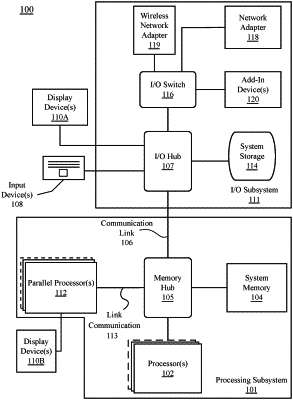| CPC G06F 1/3287 (2013.01) [G06F 1/3296 (2013.01); G06F 9/5083 (2013.01); G06F 9/5088 (2013.01); G06F 9/5094 (2013.01); G06F 13/4022 (2013.01); G06F 1/26 (2013.01)] | 21 Claims |

|
1. A graphics processor, comprising:
a first streaming multiprocessor and a second streaming multiprocessor;
the first streaming multiprocessor comprising first set of processing clusters and a first state accumulator;
the second streaming multiprocessor comprising a second set of processing clusters and a second state accumulator;
a processing resource to:
power on the first set of processing clusters;
dispatch a first workload to the first set of processing clusters;
accumulate state information relating to the workload executing on the first set of processing clusters in the first state accumulator;
monitor the first state accumulator to detect a full operating state of the first set of processing clusters, and in response to the detection of a full operating state of the first set of processing clusters, to:
power on the second set of processing clusters;
replay the state information from the first state accumulator to the second state accumulator;
dispatch operations from the first workload to the second set of processing clusters;
monitor a utilization level of the first set of processing clusters and the second set of processing clusters;
compare the utilization level of the first set of processing clusters to a threshold corresponding to a capacity level which indicates that the first workload can be processed by a single set of processing clusters;
cease to dispatch operations from the first workload to the second set of processing clusters when a utilization level of the first set of processing clusters falls below the threshold; and
power off the second set of processing clusters after operations cease on the second set of processing clusters.
|